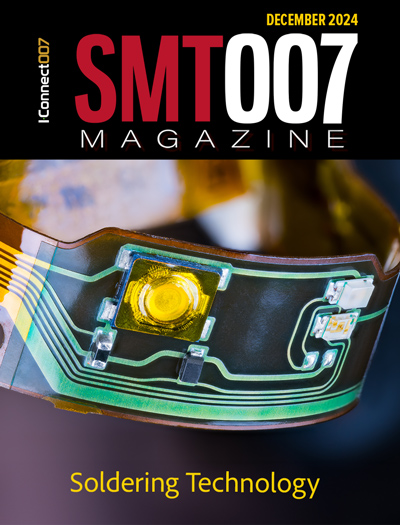-

- News
- Books
Featured Books
- smt007 Magazine
Latest Issues
Current Issue
Technical Resources
Key industry organizations–all with knowledge sharing as a part of their mission–share their technical repositories in this issue of SMT007 Magazine. Where can you find information critical to your work? Odds are, right here.

The Path Ahead
What are you paying the most attention to as we enter 2025? Find out what we learned when we asked that question. Join us as we explore five main themes in the new year.

Soldering Technologies
Soldering is the heartbeat of assembly, and new developments are taking place to match the rest of the innovation in electronics. There are tried-and-true technologies for soldering. But new challenges in packaging, materials, and sustainability may be putting this key step in flux.
- Articles
- Columns
Search Console
- Links
- Media kit
||| MENU - smt007 Magazine
Estimated reading time: 3 minutes
The New Chapter: The Impact of Parasitics on PCB Design
There are many considerations when planning and designing a board layout, and factors that include signal integrity, electromagnetic interference, and power integrity must be considered. Newer board designers often forget one factor crucial to a PCB’s performance and reliability, namely board parasitics, which usually refers to an unintended electrical effect in electronic components and interconnections. This can often lead to significant changes in the physical characteristics of the layout of the PCB. Typically, in board design, parasitics look similar to the length of a trace or a wire. Each trace is slightly resistive, slightly inductive, and slightly capacitive. These are commonly known as parasitic capacitance, parasitic inductance, and parasitic resistance.
The Impact of Managing Parasitics
Managing parasitics in board design can have a significant impact on the physical characteristics of board performance and reliability. Typically, signal integrity, power integrity, frequency response, timing, and delay, as well as EMI/EMC considerations, rely on parasitic management for certain design traits. A simulation without parasitics can compromise the design and ultimately cause it not to perform as intended.
The impact of parasitics on signal integrity, and parasitic elements such as capacitance and inductance, can lead to signal degradation, additional undesirable noise, and those potential unwanted errors in data transmission. High-frequency signals are particularly susceptible to the effects of parasitics on signal integrity.
Parasitics can also influence the distribution and integrity of power through a PCB, potentially causing loss of power and instability in power-sensitive applications, as well as inefficient energy transference throughout the board.
Parasitic elements can significantly impact the designs of frequency responses in radio frequency and microwave circuit applications, as well as alter the impedance characteristics of components and trace lines, which inevitably affect the resonant frequencies of the circuits.
With timing and circuit delays, parasitic elements can contribute to signal propagation delays. High-speed digital circuits rely on proper timing and synchronization for a designer to label a device as functional. However, with the introduction of parasitic elements, timing mismatches and synchronization issues (caused by parasitic elements inducing slight delays) can compromise the device’s overall functionality and performance.
Parasitics on electromagnetic interference (EMI) and electromagnetic compatibility (EMC) can also compromise the functionality of these circuits. Parasitics can act as unintentional antennas, ultimately radiating and causing signal crosstalk, which can lead to the board failing compliance standards and interfering with nearby devices.
Managing PCB Parasitics in a Design
Because parasitics can cause unwanted effects on a board’s functionality, it’s important for the designer to mitigate and manage parasitics during the layout process. This is achievable through component placement, board layout optimization, component selection, and simulation or analysis.
Strategic component placement can minimize parasitic effects on a board’s functionality by placing critical components closer together to reduce trace lengths. Doing so will ultimately reduce the parasitic resistance and inductance.
Careful trace routing during the layout process, as well as minimizing loop areas, are excellent ways to mitigate the parasitic inductance throughout the board and reduce the impact of parasitic capacitance. Strategically placing power and ground planes can control impedance and reduce unwanted noise in the board.
During the design process, choosing components with known parasitic elements that are deemed acceptable for certain applications can help mitigate potential issues. Certain components are designed with features to minimize parasitics and can include low-inductance capacitors for high-frequency applications.
Modern-day PCB tools include software to perform simulations and other analysis techniques to determine if a circuit will perform as expected. Using simulation and analysis tools can help predict and analyze the effects of parasitics on manufactured circuit performance. With this information, engineers can then make the best design decisions to optimize a circuit for the desired electrical characteristics.
Designers must consider the effects of parasitics before proceeding to manufacturing. Although the effects of parasitics on the functionality of PCBs may seem small, the impact can be large when it comes to the reliability and functionality of a future device. Addressing these parasitic effects through careful design decisions, board layout, and component selection is essential for optimal device performance and long-term reliability. Understanding and mitigating the effects of parasitics on board designs can help meet the strenuous demands of the electronics industry.
Understanding the essential role of parasitics in PCB design is not simply a matter of technical precision. It is crucial to ensure electronic devices operate at their peak efficiency and reliability and meet the expectations of today's interconnected world.
This column originally appeared in the August 2024 issue of PCB007 Magazine.
More Columns from The New Chapter
The New Chapter: The Benefits of Continuing EducationThe New Chapter: Navigating Maternity Leave in the Electronics Industry
The New Chapter: I’ve Found My ‘Why’
The New Chapter: Artificial Intelligence in PCB Design
The New Chapter: Lessons From the Best Engineer I’ve Ever Known
The New Chapter: Attracting ‘Generation Green’
The New Chapter: Dip Your Hand in the IPC APEX EXPO Candy Jar
The New Chapter: Easing the Learning Curve for Young Professionals


